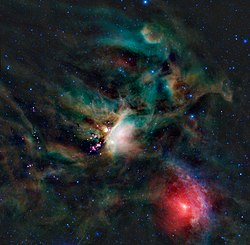Ophiuchus
Ophiuchus (Οφιούχος: say it 'Ofi-youkus'), is one of the 88 listed constellations. In Latin, it means "serpent-holder". It is near the celestial equator, and northwest of the center of the Milky Way. Ophiuchus is on the ecliptic, but is generally not considered to be in the zodiac. Its brightest star is Rasalhague.
 Click for larger image | |
| List of stars in Ophiuchus | |
| Abbreviation: | Oph |
| Genitive: | Ophiuchi |
| Symbology: | the snake-holder / the healer |
| Right ascension: | 17 h |
| Declination: | 0° |
| Area: | 948 sq. deg. (11th) |
| Main stars: | 10 |
| Bayer/Flamsteed stars: | 59 |
| Stars known to have planets: | 4 |
| Bright stars: | 5 |
| Nearby stars: | 8 |
| Brightest star: | α Oph (Ras Alhague) (2.1m) |
| Nearest star: | Barnard's Star (5.96 ly) |
| Messier objects: | 7 |
| Meteor showers: | Ophiuchids Northern May Ophiuchids Southern May Ophiuchids Theta Ophiuchids |
| Bordering constellations: | Hercules Serpens Caput Libra Scorpius Sagittarius Serpens Cauda Aquila |
| Visible at latitudes between +80° and −80° Best visible at 21:00 (9 p.m.) during the month of July | |
The Voyager 1 probe is within the borders of Ophiuchus.
Ophiuchus Media
Infrared light view of Rho Ophiuchi molecular cloud complex from NASA
Photo from Rogelio Bernal Andreo of the Rho Ophiuchi molecular cloud complex
Hercules and Ophiuchus, 1602, by Willem Blaeu.
Johannes Kepler's 1606 book De Stella Nova in Pede Serpentarii (On the New Star in Ophiuchus's Foot) opened at the page for Ophiuchus.
Ophiuchus in a manuscript copy of Azophi's Uranometry, 18th century copy of a manuscript prepared for Ulugh Beg in 1417 (note that as in all pre-modern star charts, the constellation is mirrored, with Serpens Caput on the left and Serpens Cauda on the right).
Ophiuchus holding the serpent, Serpens, as depicted in Urania's Mirror, a set of constellation cards published in London c. 1825. Above the tail of the serpent is the now-obsolete constellation Taurus Poniatovii while below it is Scutum.







